Image optimization makes sure images look good, load fast, and help with SEO.
It involves making images smaller without losing quality and adding useful information to them.
Importance of Image Optimization for SEO
Image optimization is super important for a few big reasons:
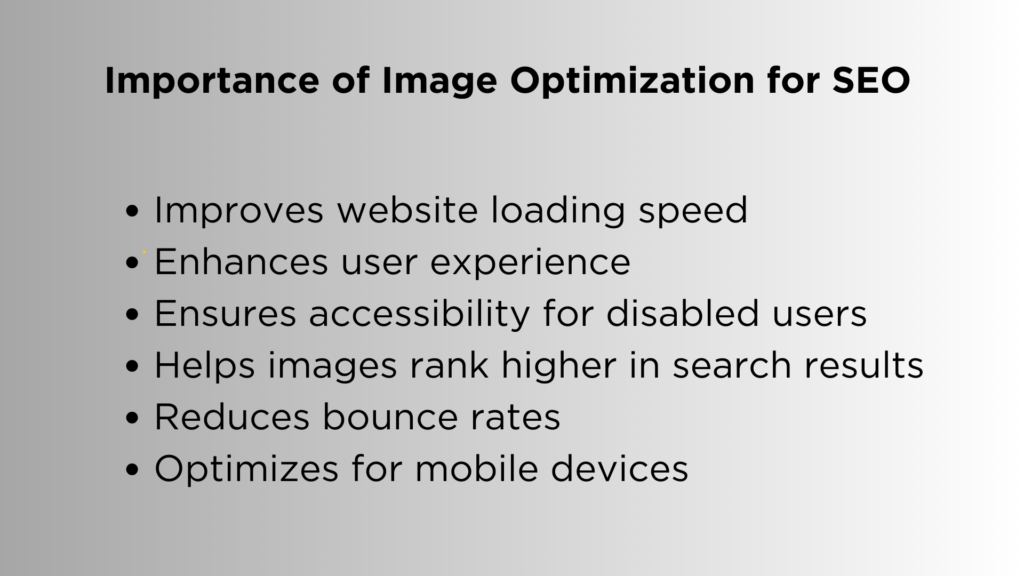
1. Faster Websites:
- Big images slow down websites.
- Slow websites need to rank better on Google.
- Making images smaller without losing quality helps websites load faster.
- Faster websites rank better on Google.
2. Happier Visitors:
- People prefer quick websites.
- Slow websites make people leave quickly.
- Optimized images make websites load faster.
- Faster websites keep visitors happy and engaged.
3. Helping Everyone:
- Adding details to images helps search engines understand them.
- Alt text allows people who can’t see to understand what’s in the pictures.
- Good image details make websites better for everyone.
3. Getting Found:
- Well-optimized images show up higher in Google search results.
- Google likes images with good names and alt text.
- Good image details attract more visitors to websites.
4. Keeping Visitors:
- Slow-loading websites make people leave fast.
- Fast-loading websites keep people around longer.
- Optimized images make websites load faster.
- Faster websites keep more visitors.
5. Mobile Friendliness:
- Lots of people use phones to browse the internet.
- Optimized images make websites load quickly on phones.
- Google likes websites that work well on phones.
In short, image optimization helps websites load faster, keeps visitors happy, improves SEO, and attracts more people.
Choosing the Right Image Format
Picking the right image type is essential for making images look good on websites:
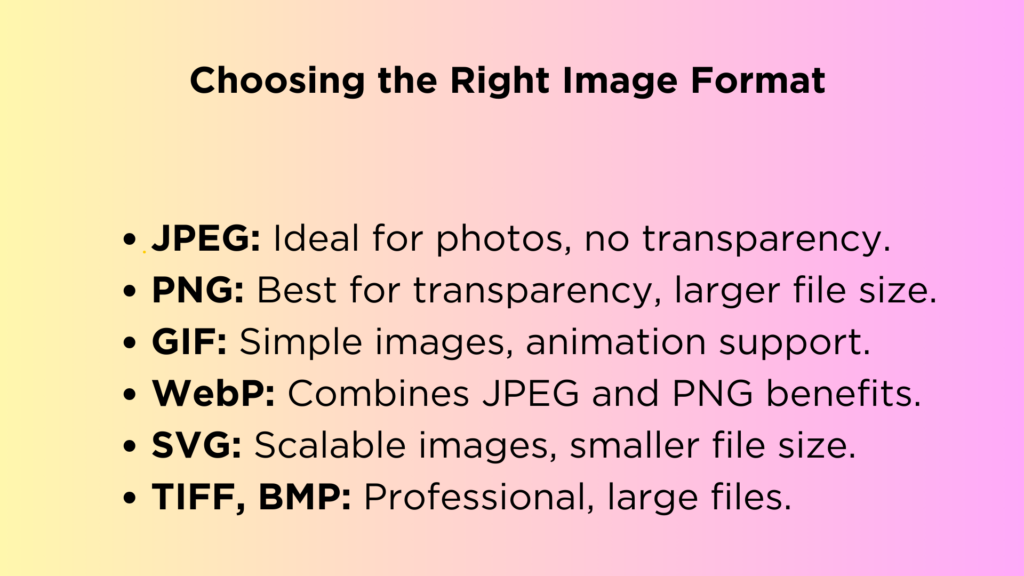
1.JPEG:
- Good for photos and colorful images.
- It makes files smaller but can’t have transparent parts.
2.PNG:
- Great for images with clear parts or logos.
- It keeps quality high, but the files are more extensive.
3. GIF:
- Works for simple animations.
- Not great for detailed images.
4.WebP:
- New format with good quality and small sizes.
- Still needs to be supported by all browsers.
5. SVG:
- Perfect for logos and icons.
- Makes images look good on all screens.
6. TIFF:
- Best for professional printing.
- Not suitable for websites because files are enormous.
7.BMP:
- It could be better for websites.
- Makes big files and slow websites.
Choosing the correct format depends on what the image is for and how detailed it is.
Image Compression Techniques
Making images smaller without losing quality is essential for websites.
Here’s how it’s done:
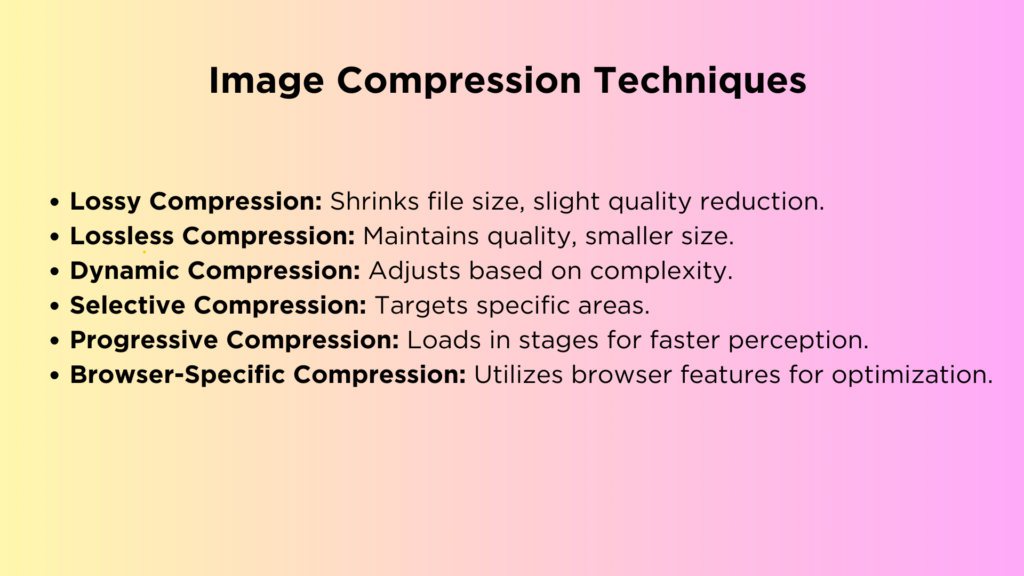
1. Lossy Compression:
- Shrinks files by removing some details.
- Suitable for photos and big images.
2. Lossless Compression:
- Shrinks files without losing details.
- Works well for logos and clear images.
3. Dynamic Compression:
- Changes how much compression is used based on the image.
- Balances quality and file size well.
4. Selective Compression:
- Picks which parts of an image to shrink.
- Keep important parts detailed.
5. Progressive Compression:
- Shows images in parts as they load.
- It makes websites look faster to visitors.
6. Browser-Specific Compression:
- Uses different methods depending on the web browser.
- It makes websites load fast for everyone.
These methods help websites load faster and keep visitors happy.
Image Size and Dimensions
Making sure images fit well on websites is essential for making them look good and load fast:
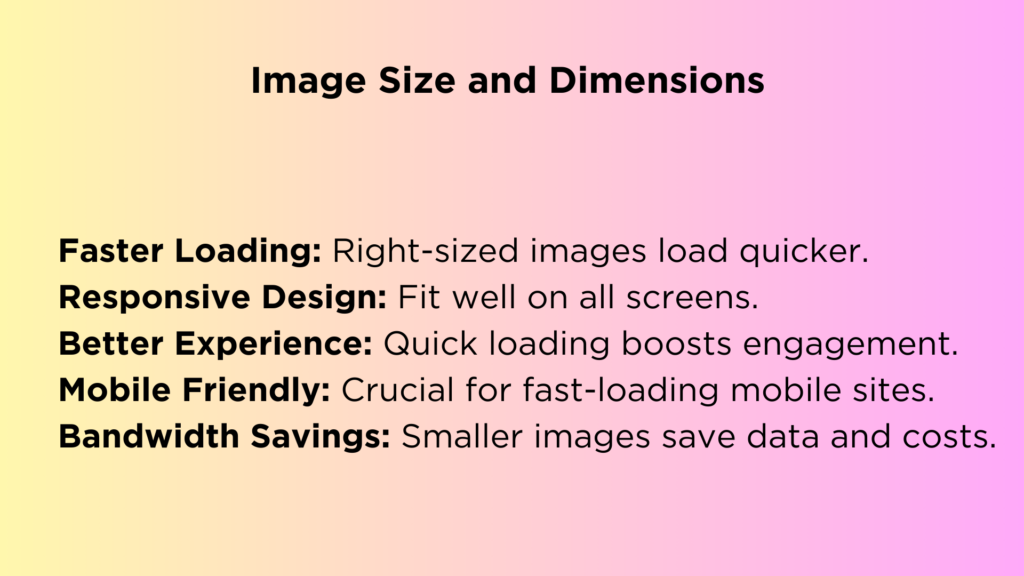
Faster Loading:
- Right-sized images load quickly.
- Visitors prefer quick websites.
Responsive Design:
- Images should look good on all screens.
- People use phones and computers to visit websites.
Better Experience:
- Quick websites keep people around longer.
- People like websites that work well.
Mobile Friendly:
- Most people use phones for the internet.
- Websites should load fast on phones, too.
Saving Bandwidth:
- Smaller images use less data.
- Helps people on slow connections or with limited data plans.
In short, making sure images fit well on websites makes them look good and load fast.
Descriptive Filenames and Alt Text
Giving images good names and descriptions helps people understand them and helps websites rank better:
Good Names:
- Pick names that describe the image.
- Add words that people might search for.
Alt Text:
- Describes images for people who can’t see well.
- It also helps search engines understand images.
Good names and alt text make websites better for everyone.
Image Title and Caption Optimization
Giving images good titles and captions helps people find them and understand what they’re about:
Good Titles:
- Describe what’s in the image.
- Add words that help people find the image.
Helpful Captions:
- Give more details about the image.
- Include words that describe the image.
Titles and captions help websites appear better in search results and make them easier to understand.
Structured Data Markup for Images
Adding extra information to images helps search engines understand them better:
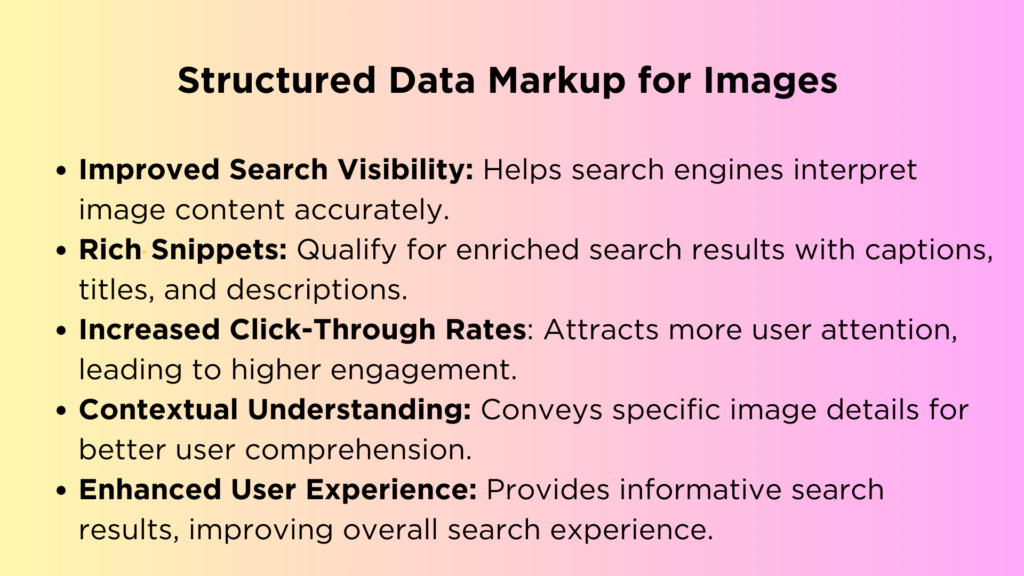
Show Up Better:
- Extra details make images stand out in search results.
- People are more likely to click on pictures with extra info.
Rich Snippets:
- Extra info can show up under images in search results.
- It helps people know what the image is about.
More Clicks:
- People are more likely to click on images with extra details.
- It helps websites get more visitors.
Better Understanding:
- Extra information helps search engines show images to the right people.
- It makes search results more useful for everyone.
Adding extra info to images helps websites get found and improves search results.
Lazy Loading Implementation
Lazy loading is a trick that makes websites load faster:
How It Works:
- It only loads images when people can see them.
- It saves time and data because it doesn’t load hidden photos.
Benefits:
- Websites load faster because they don’t load everything at once.
- People are happier because websites look faster.
- Lazy loading is suitable for websites because it makes them load quickly and keeps visitors happy.
CDN Integration for Image Delivery
CDNs help websites load quickly by keeping images close to people:
How It Works:
- Copies images to servers all over the world.
- Loads images from the closest server to the visitor.
Benefits:
- Websites load faster because images are closer.
- People are happier because websites work well.
Using CDNs makes websites load faster for everyone and keeps visitors happy.
Testing and Monitoring Image Performance
Checking how well images load is essential for keeping websites working well:
Why It’s Important:
- It helps find ways to make websites faster.
- Make sure websites work well on all devices and browsers.
Tools to Use:
- Google PageSpeed Insights: Tells how well websites load and gives ideas for making them faster.
- GTmetrix: Checks how fast websites load and offers tips for improving speed.
- Browser Developer Tools: Built-in tools in web browsers that help find problems with websites.
Checking how well images load helps websites stay fast and work well for everyone.
Conclusion and Best Practices
Ensuring images look good, load fast, and help with SEO is essential for websites.
Following the best ways to do this helps websites get more visitors and keep them happy.
There you go! It’s all in more straightforward language now. Let me know if there’s anything else you need!